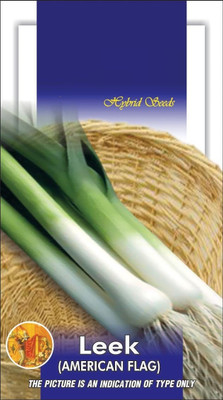VibeX Leek Seed Seed(120 per packet)
Quick Overview
Product Price Comparison
Like garlic and leeks, onions too are an allium vegetable that were cultivated 2000 years ago in ancient Egypt. Particularly rich in polyphenol and flavanoids, care should be taken not to over-peel the papery layer of onions for fear of losing much of the essentials. Including onions in your diet is also a great way to prevent colorectal, laryngeal, ovarian, oral, and esophageal cancers. It has been specially effective to keep the heart and blood vessels in an excellent condition and a great defense against heart attacks. There is good news for menopausal women too! Eating onions can help them gain bone density and lower the risk of fractures due to accidental falls. Also rich in sulphur, onions are very beneficial for the formation of connective tissues. The other main nutrients found in onions include Vitamin A, B6, C, E, sodium, potassium, iron, and dietary fibre. Onions also contain the coveted allyl propyl disulphide which helps in maintaining optimum blood sugar levels too.Mostly, onions are eaten raw in salads, sandwiches, and other savoury side dishes. While they can be cooked in a variety of styles. Sautee, steam, bake, grill, boil or have a soup made entirely and just of onions! Have them any which way you like, but be sure to make them a part of your meals so as not to miss out on the benefits.Like garlic and leeks, onions too are an allium vegetable that were cultivated 2000 years ago in ancient Egypt. Particularly rich in polyphenol and flavanoids, care should be taken not to over-peel the papery layer of onions for fear of losing much of the essentials. Including onions in your diet is also a great way to prevent colorectal, laryngeal, ovarian, oral, and esophageal cancers. It has been specially effective to keep the heart and blood vessels in an excellent condition and a great defense against heart attacks. There is good news for menopausal women too! Eating onions can help them gain bone density and lower the risk of fractures due to accidental falls. Also rich in sulphur, onions are very beneficial for the formation of connective tissues. The other main nutrients found in onions include Vitamin A, B6, C, E, sodium, potassium, iron, and dietary fibre. Onions also contain the coveted allyl propyl disulphide which helps in maintaining optimum blood sugar levels too.Mostly, onions are eaten raw in salads, sandwiches, and other savoury side dishes. While they can be cooked in a variety of styles. Sautee, steam, bake, grill, boil or have a soup made entirely and just of onions! Have them any which way you like, but be sure to make them a part of your meals so as not to miss out on the benefits.PLANTING INSTRUCTIONSOnion likes cool weather in the early part of their growth, so plant them in spring, except in mild-winter areas, where onions are grown as a fall or winter crop.Place them about an inch deep in the soil and approximately half an inch or more apart. If planting rows, space them at least one and half to two feet apart.GROWING REQUIREMENTSPESTSThese pests attack the crop - Downy mildew, Powdery mildew, Cutworms, Armyworm, Aphids (Willow-carrot aphid).The mentioned pests may cause the crop witness these symptoms: swollen or distorted; stunted growth, white fluffy growth on underside of leaves; honeydew which encourages the growth of sooty mold on the plants etc.SOILOnion benefits from a rich, well-drained soil, with a pH of 5.5-6.8SPOTPlant in a sunny spot for best results.TEMPERATUREOnion germination is fastest as 20-25┬░C (68-77┬░F)WATERINGWater regularly, giving plants at least an inch of water per week (more in hot weather)HOW TO HARVESTThe bulbs are harvested when they contract to small tennis ball size.Use a sharp knife or pruners to make out the bulb free just above taproot, right at the soil line. Trim the leaf stems about 1-2" above the bulb to prepare it for sale or computer memory.Bulb fennel requires 80-115 frost-free days to hand harvest. Bulb fennel can be kept in the refrigerator for up to 1 week or in a cold moist place for 2 to 3 months.The best storage conditions are 0┬░C [32┬░F] with 95% relative humidity. Stems can be dried or frozen; leaves can be frozen or dried as herbs.Dried leaves should be salted away in an airtight container.


